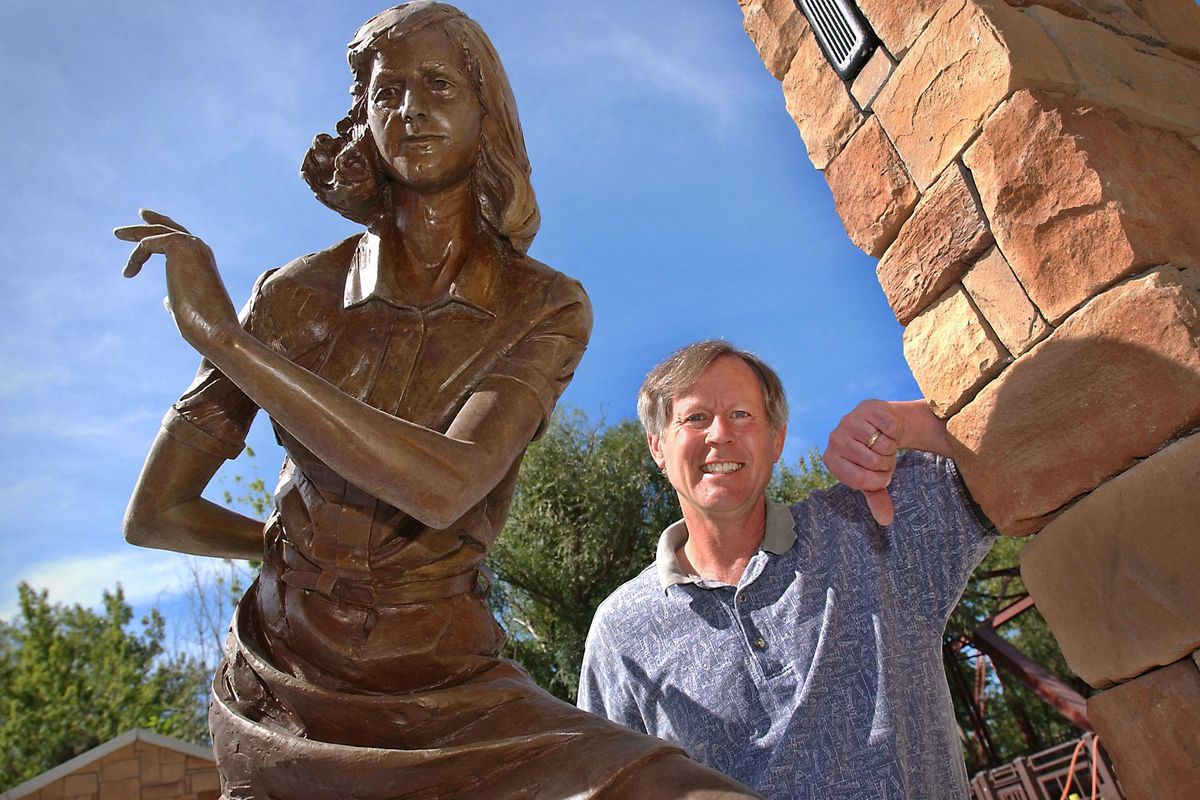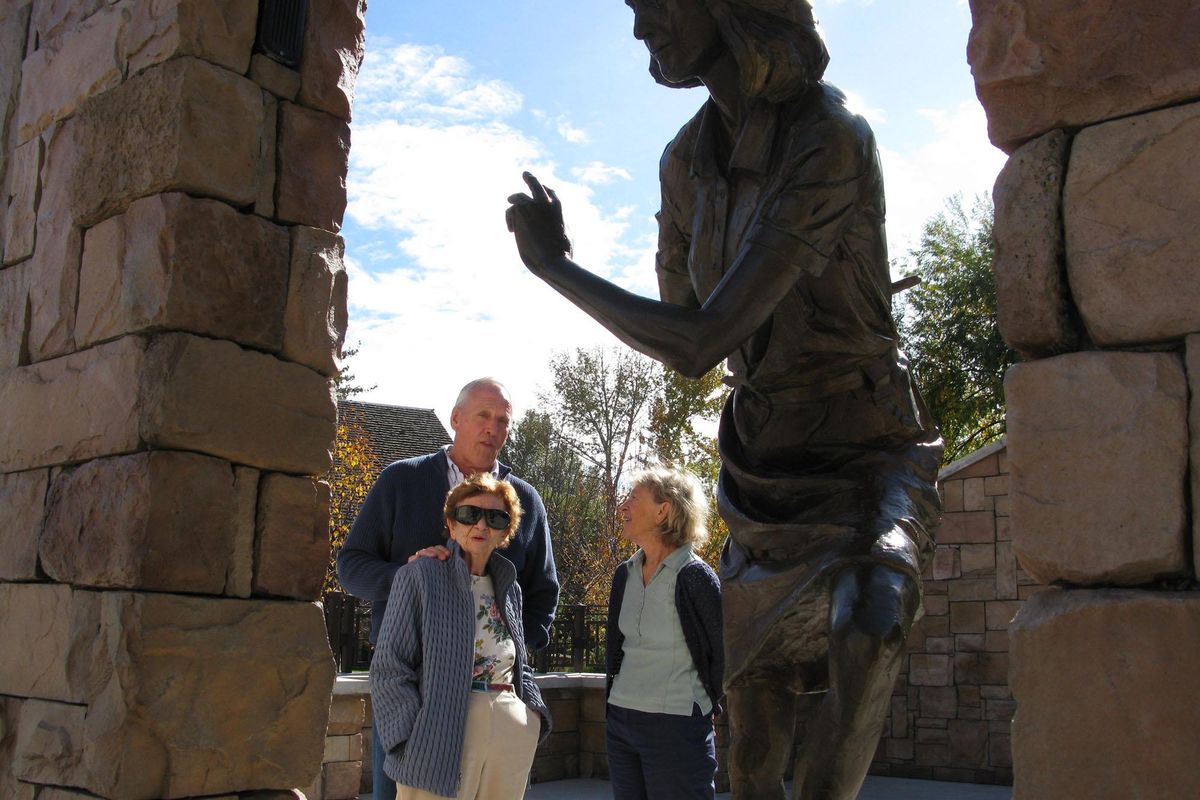This column reflects the opinion of the writer. Learn about the differences between a news story and an opinion column.
Eye on Boise: Vandalism at Anne Frank memorial called hate crime; community support for memorial swells
FILE – Les Bock, of the Idaho Human Rights Education Center, stands next to a bronze statue of Anne Frank in the new Anne Frank Human Rights Memorial in Boise on Aug. 13, 2002. (TROY MABEN / AP)
BOISE – The Idaho Anne Frank Human Rights Memorial has been defaced with racist and anti-Semitic graffiti three times in the past week, causing extensive damage to marble tablets at the memorial.
Boise Police Chief Bill Bones told the Idaho Statesman on Thursday that the attacks are being treated as a hate crime.
“There’s an obligation to call this what it is. It’s a cowardly act. It’s a criminal act,” he said. “The words that they wrote are obviously attacks against people that live in this community simply based on the religion they practice or the color of their skin.”
The Wassmuth Center for Human Rights, which operates the memorial in partnership with Boise city parks department and has its offices next door, reported an outpouring of community support, including two individual donors who came to the center’s office and donated $20,000 apiece on Thursday – the estimated cost to replace two marble tables damaged in the first of the three incidents. Two online fund-raising drives are raising thousands more.
Dan Prinzing, the center’s director, told the Statesman, “We are being told, ‘Yes, repair. Yes, replace. But also: Enhance. Build more.’ It’s been an overwhelming response.”
The memorial is an educational park dedicated in 2002, funded by contributions from more than 3,000 individuals and corporations. Schoolchildren across the state collected coins to fund a life-sized, $42,000 bronze sculpture of Anne Frank, the young holocaust victim whose diary is among the world’s most widely read books and has been translated into more than 60 languages. In her diary, Frank famously wrote, “I still believe, in spite of everything, that people are truly good at heart.”
The site functions as an outdoor classroom, a place of contemplation, a tourist attraction, a gathering place and a monument.
Located along the Boise River Greenbelt in downtown Boise, the memorial features the statue of Anne, peering out a window; inspiring quotes from more than 60 of the world’s humanitarian leaders; benches and reading areas; marble tablets engraved with the 30 articles of the Universal Declaration of Human Rights, one of the few places in the world where the full declaration is on permanent public display; waterfalls; reflecting ponds; serene landscaping; and several other features aimed at contemplation, inspiration and human rights. It is the only permanent Anne Frank memorial in the United States.
The Statesman noted that the vandalism at the Anne Frank memorial follows other racist vandalism in Boise in recent months: In December, a racist slur was written in the snow on the roof of a storage shed at the Black History Museum; and in the fall, a Black Lives Matter homecoming float at Boise State University was targeted.
The New York City-based Anne Frank Center for Mutual Respect announced that it will send a team to Boise in response to the incidents; the team will include actors to perform “Letters from Anne and Martin,” a play featuring writings from Anne Frank and Martin Luther King Jr., on May 24.
New budget director named
The Idaho Legislature’s longtime budget director, Cathy Holland-Smith, is retiring after nearly 30 years with the state, the last 10 as the director of the Legislature’s nonpartisan Division of Budget and Policy. Her last day was Friday. On Monday, Paul Headlee, who has been a nonpartisan staffer with the Legislature for 15 years, the last three as deputy budget director, will take over as director. Headlee is well-known to state lawmakers as the legislative budget analyst for the public schools budget. That duty will be taken over by budget analyst Robyn Lockett.
“I know that Paul will be terrific in his new position,” said Legislative Services Director Eric Milstead, in an email informing lawmakers of the move.
Headlee has named budget analyst Keith Bybee as his deputy director, and is in the process of hiring several new budget analysts. He noted that with the retirements of Holland-Smith, longtime analyst Richard Burns last year, and longtime analyst Ray Houston coming in July, the office is losing a combined 90 years of experience.
“We have some good folks here. We have a good corps of senior staff that are going to help the junior staff as they come on board,” Headlee said. “We have some pretty big tasks ahead. And as long as everybody will bear with us a little while we make all the assignment changes, we’ll be learning from each other.”
Candidates already sparring…
When Steve Yates, who recently stepped down as executive director of the Idaho Republican Party, filed preliminary paperwork with the Idaho Secretary of State’s office last week for a run for lieutenant governor, it reminded me of comments last month from another candidate for the same post, Sen. Marv Hagedorn, R-Meridian. After a column by Chuck Malloy in Idaho Politics Weekly speculated that Yates entering the race likely would chase away other potential candidates and that Hagedorn, who at that time was the only announced candidate, “might want to rethink his plans,” Hagedorn responded on Facebook:
“Having been an Idahoan most of my life, growing up with Idahoans and having lived in both northern and southern Idaho has provided me a perspective of why we are who we are. I’ve appreciated Steve’s efforts to bring our party together (as a volunteer in a part-time job), but three years dealing with party officials doesn’t give one the perspective of what Idaho is and who Idahoans really are. There will be more good candidates entering this race who I consider my friends, and I look forward to debating and traveling all over the state with them, and communicating our experiences letting Idahoans decide who will be the best person to provide back-up and guidance to whoever our new governor will be!”
It’s a crowded race already. Since then, Rep. Kelley Packer, R-McCammon, and former Rep. Janice McGeachin, R-Idaho Falls, both have entered the race and launched their campaigns. Former Constitution Party gubernatorial candidate Steve Pankey of Twin Falls also has filed as a Republican for the post.
Idaho’s lieutenant governor, a part-time position, presides over the Senate and serves as acting governor when the governor is outside the state or incapacitated. Other duties depend on those delegated or assigned by the governor.
Current Lt. Gov. Brad Little has held the post since 2009. It’s opening up next year because he’s running for governor.
April tax revenues beat forecasts
Idaho state tax revenues in April came in 2.4 percent ahead of forecasts, at $537 million. That’s 5.9 percent higher than last year’s April figures and is significant as April is the biggest revenue month of the year, since it’s when people file their income tax returns. With the April revenues in, year-to-date tax revenues to Idaho’s general fund are $2.9 billion, 1.8 percent ahead of forecasts and 7.8 percent higher than last year at the same point.
Even so, individual income taxes, the largest component of April’s revenues, came in half a percentage point below the forecast. Both sales taxes and corporate income taxes beat forecasts, as did smaller revenue categories, boosting the total, according to the governor’s Division of Financial Management.
Meanwhile, the Legislative Budget Office reports that the estimated ending balance at the end of the current fiscal year stands at $76.4 million, $2.9 million higher than was anticipated when lawmakers adjourned their legislative session in March. With this year’s successful legislation to extend a “surplus eliminator” law, any general fund year-end balance that exceeds the ending balance set by the Legislature will be divided equally between the Budget Stabilization Fund, which is the state’s main rainy-day savings fund, and road projects.
Since the Legislature set that ending balance at $73.4 million, the amount now built up for purposes of the surplus-eliminator is $2.9 million.


